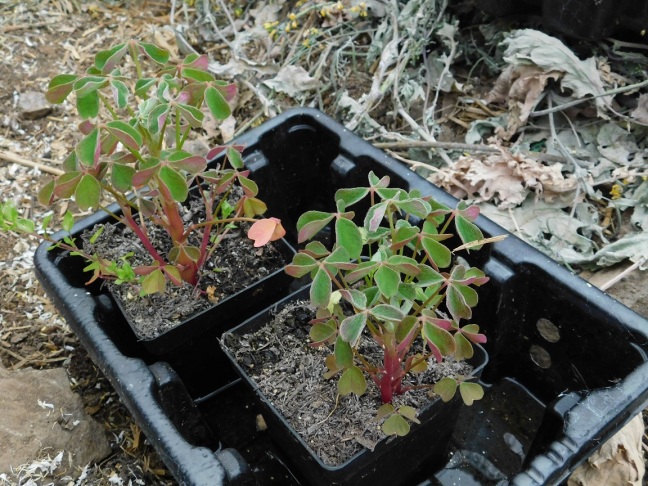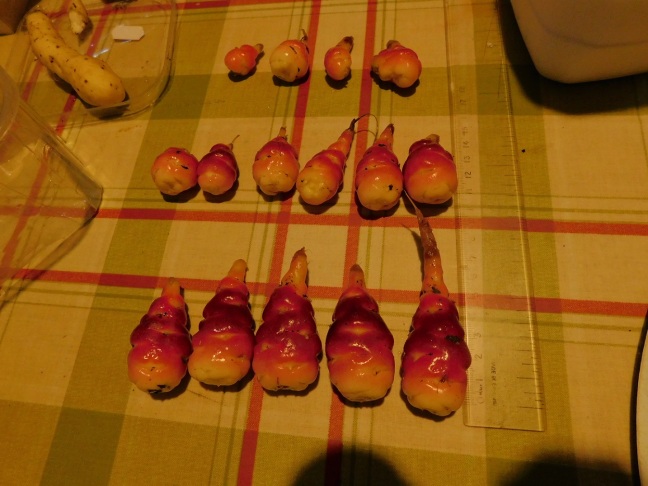
I have harvested all the oca now. I had three tubers given to me by Frances of island threads, who lives on one of the outer Hebrides, so just over the water from me. Her weather is probably even milder, and windier, but just a trifle drier perhaps. I started the tubers off in pots and planted two in the polytunnel and one outside in June. Frances assures me that she grows hers outside, but I wanted to be safe till I have enough tubers to risk.
Oca: oxalis tuberosa, is related to wood sorrel and has similar clover-like leaves that are edible but contain oxalic acid (like rhubarb leaves) so should only be eaten sparingly. I think they are a bit tough in my experience anyhow compared to common sorrel, and with a less sharp lemon taste. They are grown mainly for the edible tubers which come in a range of colours. Like potatoes, they are propagated mainly vegetatively through replanting the tubers since although they flower, they appear to rarely set seed, at least in the UK. A number of growers are aiming to get more productive varieties in the northern hemisphere, see cultivariable and the UK oca breeders project for example.
Oca forms tubers after the daylength is less than 12 hours – generally said to be at the end of September in the UK. This will of course vary with latitude. On Sept 30th in Glasgow (55deg 51min N) the daylength is 11 hrs 37 min, London (51deg 30min N) is given as 11hours 40min long. Here on Skye we are at 57 deg north (or thereabouts) so a little shorter in daylength than Glasgow in winter. At the winter solstice the days are pretty much as short as they get – still pretty dark at 8am and getting dark at 4pm. Since we can expect hard frosts by the end of November that means the oca only has about two months here to form tubers outside.
I’m pretty pleased with the results from the outside plant as a first trial. It grew happily despite having very little shelter from the wind. It flowered at the start of September with delicate yellow flowers. Light frosts in late October were survived, but it was knocked back completely in December. Although I harvested the outside plant when this happened, I since read that the tubers can carry on growing for several weeks after the foliage has apparently died down – the fleshy stalks carry on feeding them for longer, so I maybe should have left it a little longer to bulk up. However, I got almost exactly 8 ounces and all 15 tubers are of a size that can be used: up to about 6cm (over 2 in) long. The plant received a little compost in the hole when it was planted, and otherwise was just let to get on with it.

At the start of February I harvested the two plants in the tunnel. The plants had stayed green much longer, and it took a prolonged frost when we had the snow in January to fully knock them back. Although the plants had never looked quite as good as the ones outside, I was hopeful that they would do better, since they were still quite green at the end of the year. However the yield was quite disappointing: 3 1/2 Oz from each plant. The tubers were generally smaller, with quite a bit of slug damage (or it may have been vine weevils?) I suspect that it was a bit too dry for them in the tunnel. I have not been watering much in there over the winter, since it tends to lead to mildew.

I tried the smallest from outside raw and was bit disappointed in the flavour to be honest. I had seen them described as crunchy and lemony sharp, getting sweeter as they are exposed to sunlight. I would describe the taste (fresh) as having a faint raw potato flavour, with a hint of lemon perhaps, but not nice enough to serve to S. So far I have only cooked them by boiling and that was perfectly pleasant, like a creamy salad potato. The colour does fade a bit on cooking. They can be boiled, fried, and baked just like potatoes. In New Zealand they are known as yams and are very popular. I have found a few suggestions for roasting them, so I may try that next.

I have enough tubers to grow next year, and enough to experiment a bit with different ways of cooking. Some are in the fridge, and some on a cool windowsill. I think I won’t bother with planting any in the tunnel next year, although I may try covering with fleece or cloches at the end of the season outside, if I can work out how to stop those blowing away! They can go in orchard borders that need digging anyway to keep couch grass at bay. I think they will definitely be worth growing again, and I have also got some different tubers of various colours from real seeds to try some different varieties!

wow that is quite a difference between outside and tunnel grown, thanks for all the extra information, I’ve never tried them raw or tried the leaves, I didn’t even know the leaves were edible though I think I might give them a miss, I had roast ocas with potatoes, jerusalem artichokes and courgette also all roasted today, I’ll be interested to see and hear how the different varieties grow and taste, Frances
LikeLiked by 1 person
Roasted is my next plan! I believe all parts are edible, and I guess the growing conditions will affect the flavour and texture. Oxalic acid, which gives the lemony flavour, isn’t good for you in large quantities anyhow.
LikeLiked by 1 person
Wow that is really interesting. I just did some research – it looks like they will grow here too, provided we plant after the frost. Thanks for creating the awareness. Good first harvest you had!
LikeLiked by 1 person
I’m quite encouraged.
You may find it a little hot there – it would probably need a bit of shade and plenty of moisture with you. There are probably some good varieties in NZ if they can be imported locally (or already have been)
LikeLike
I was surprised to read that there was very little difference in the length of the day between the north and south of Britain: almost a thousand miles and only about ten minutes, taking into account both ends of the day.
Anyway, I have a feeling oca would be difficult for me to grow with my locality being so dry. It would be interesting to see what it tastes like, so perhaps I could suggest it to the local organic farm.
LikeLiked by 1 person
It does seem to thrive on our damp soil, and has definitely been fun to grow – the tubers are lovely colours (I’ve got a good range from real seeds too!)
I think that the equinox (sept & march) is when the day length is most similar – you’d need an astronomer to explain why! There is certainly more difference in midsummer and midwinter however.
LikeLike
Might be something to do with the curvature of the Earth.
LikeLike
I wasn’t able to find a good site quickly, but the lower graph here confirms that daylength is similar all over the globe at the equinoxes: http://astrosun2.astro.cornell.edu/academics/courses/astro201/sun_rise.htm
LikeLike
Thank you, Nancy. That’s interesting.
LikeLike
I’ve never heard of Oca, but sounds like something worth trying to make use of some empty ground. Will be doing some research 😊.
LikeLiked by 1 person
Good luck!
LikeLiked by 1 person
I’d love to give them a go as they are so pretty. Might wait for your roasting update as I’ll only grow them if they taste good 😀
LikeLiked by 1 person
That sounds reasonable to me! I’ll update later.
LikeLike
Just discovered this blog! Brilliant! I’m originally from Sleat, but now live in Cambridgeshire. Just wasted about an hour of work reading through your pages – really good job!
LikeLiked by 1 person
Feasgar math! Actually that’s almost the limit of my gaelic I’m afraid. Tapadh leat, for your kind comments. I do this mainly for my own records, and hope that anyone else will find it interesting. It’s not particularly a Skye ‘blog, more about learning to grow different plants in a wet windy environment. Good luck with your studies.
LikeLike
No worries, chan eil gaidhlig agam either. Yeah I’m really impressed by what you’ve grown in your poly-tunnel, especially on Skye I know the struggles. I really notice the difference in climate – down here I can grow tomatoes outside! Crazy!
Actually bumped into your blog as I recently bought these Oca tubers for my other half recently – no idea how they will do but they look interesting…
LikeLiked by 1 person
They are rather cute. I never grew them before, so can’t give much else in terms of advice. Have fun!
LikeLike
I have bounced around from Cambridgeshire all over the place but a regular visitor to Skye these days. ☺
LikeLiked by 1 person
They’re very pretty–if they’re called yams in New Zealand, does that mean they’re like a sweet potato?
LikeLiked by 1 person
Oca (oxalis) are not related to other plants called yam which are ipomea (sweet potato) or dioscorea (yam). These both tend to need warmer summers.
I have grown japanese yam (dioscorea japonica), which is more temperate, with limited success so far I’m afraid. I’ve grown it in the polytunnel, but I think it didn’t get enough water. Tastes nice, like baked potatoes!
The sweet potato, again not very successful in tunnel, grew OK, but tiny thin tubers – probably too little light, or moisture.
LikeLiked by 1 person
They still look really beautiful!
LikeLiked by 1 person